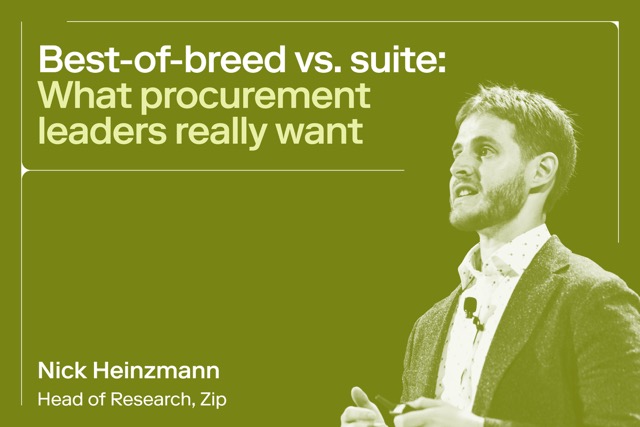.webp)
Supplier relationship management (SRM): Your go-to guide
Learn how to improve efficiency, reduce costs, and drive innovation with effective supplier relationship management strategies.

As a procurement professional, you know that nurturing relationships with suppliers helps maximize value, reduce risk, and drive mutual success. That’s why investing in quality supplier relationship management (SRM) practices is so important.
Also referred to as vendor management, SRM allows you to foster mutually beneficial partnerships while improving collaboration and innovation. Let’s explore the various aspects of SRM and the key benefits and challenges you may encounter when implementing an SRM strategy.
What is supplier relationship management?
Supplier relationship management is a strategic approach to managing and nurturing relationships with suppliers. It involves establishing and maintaining long-lasting collaborative partnerships with suppliers based on trust, transparency, and open lines of communication.
Part of SRM is determining the value each supplier provides and which ones play a pivotal role in your business’s success. To do this, you can collect data to gauge each supplier’s performance and put the data into two categories:
Quantitative:
- Adherence to delivery times
- Dispute resolution time
- Cost savings achieved
- Supply chain disruptions
Qualitative:
- Satisfaction with supplier relationship
- Potential risks
- Communication quality
- Areas for improvement
This data gives you a sort of scoring system to better understand the value of each supplier.

How does supplier relationship management work?
A strong SRM system can help you reach and exceed your goals with suppliers. Here’s how it works:
1. Supplier segmentation
Segmenting your suppliers can help you allocate resources and attention more effectively. Some considerations that may play into your segments include:
- Strategic importance: How important the supplier is to business operations
- Risk level: Potential risks like pricing volatility or supply disruptions
- Relationship status: Can include communication, collaboration, and other factors that make working with the supplier good or bad
- Performance: How well the supplier is meeting quality, delivery, and cost expectations
Categorizing your suppliers gives you a bird's-eye view of which ones need attention—and what type of attention. For example, you may need to keep an eye out for early signs of delays with a high-risk supplier, or you might want to set reminders to check in a bit more with certain suppliers who are generally more distant and less communicative.
2. Supplier selection and onboarding
Be sure to properly research and evaluate suppliers to avoid potential issues down the line. When vetting suppliers, consider whether they align with your organization’s strategic goals and quality standards. It’s also helpful to consider potential risks like supply chain disruptions.
You can evaluate suppliers by seeing who they currently work with and how long they’ve maintained the relationship. It may also be a good idea to ask for references from other businesses so you can hear about the supplier’s work before signing a contract.
The onboarding process is critical to starting off on the right foot with new partnerships. It’s especially helpful to have supplier relationship management software that can seamlessly integrate with the supplier’s systems. Take the time to train key stakeholders on vendor processes to prevent delays and miscommunications as well.
3. Establishing clear expectations
Clear communication of expectations creates a solid foundation. When both parties have a shared understanding of their roles, responsibilities, and performance requirements, you increase the trust and transparency between you and your suppliers.
During negotiations and onboarding, listen well and take notes. Ask clarifying questions if something is unclear. When communicating with the supplier, be direct, upfront, and transparent about what you expect from them.
This is a mutually beneficial relationship, so it’s important to create an environment where both parties can share their thoughts and feedback openly.
4. Performance monitoring
Performance monitoring should be an ongoing part of your SRM strategy. You can assess each vendor’s performance by having clear KPIs, including the quality of products, on-time deliveries, and customer satisfaction. To make this process easier, you can use vendor management software to enhance your data collection and analytics.
5. Communication and collaboration
Clear communication extends beyond onboarding and should be a top priority throughout your entire partnership to maintain a great relationship with your suppliers. When both parties communicate effectively, you reduce the risk of delays or errors with orders. Try to respond to suppliers within 24 hours, and communicate any updates or changes regularly.
It’s also helpful to set up regular meetings to discuss progress and address any issues. This gives you a formal time to sit down and problem-solve together. When you collaborate on your goals, you both win.
6. Risk management
Risk management helps you identify, assess, and mitigate potential issues like pricing fluctuations, supply chain disruptions, supplier delays, quality issues, and more. Assessing each vendor before signing a contract with them is ideal, but some risks are unavoidable.
Sometimes, the best thing you can do is reduce the impact of disruptions by being prepared. Regularly monitor each vendor and have contingency plans in place. If there are ongoing issues with a supplier, assess the situation to see if you can solve the problem or need to vet new suppliers.
7. Contract and compliance management
To maintain a good relationship, both parties should uphold their end of the agreed-upon contract. Part of your performance tracking for suppliers should include compliance checks, confirming that the supplier is abiding by all legal and regulatory requirements.
Goals and benefits of supplier relationship management
Now, let’s dive into some specific metrics that help you evaluate and assess your relationships with suppliers.
Cost savings
A good supplier relationship should save you money. Not only should your supplier have competitive pricing, but they should be willing to offer discounts for consolidating purchases, renewing your contract, and increasing your order quantities. Your bottom line will benefit from this cash flow strategy.
Improved supplier performance
When you treat suppliers well, they treat you well in return and provide you with great service. As you strengthen your relationship with suppliers, you may see improvements in a variety of areas, including:
- More on-time deliveries
- Lower defect rates
- Increased customer satisfaction
- Better adherence to contractual and regulatory requirements
- Increased order fill rates
Enhanced collaboration and innovation
As you and your supplier begin to trust each other more, you become a team that can collaborate and innovate together. Collaboration allows you to work together to solve problems and ensure you both benefit from the relationship. With this teamwork, you and your supplier can come up with innovative ideas to improve operations for both of your organizations.
Risk mitigation
Quality supplier relationship management means you’re monitoring your suppliers and know how to mitigate potential risks. This is beneficial because you’re not caught off guard. You know which suppliers are more likely to send defective products or have delays, so you can have a strategy in place to avoid disruptions to your operations.
Increased customer satisfaction
Maintaining a strong supplier relationship leads to results that benefit your customers. SRM helps your operations run smoothly, so your customers don’t experience delays and they receive high-quality products. Happy customers means higher retention rates and better reviews.

Challenges of SRM
As you strengthen your supplier relationships, you’ll probably run into some bottlenecks. Knowing the common obstacles can help you be more prepared as you develop your SRM strategy:
- Lack of clear communication: Misunderstandings and inefficiencies can arise from poor communication or a lack of a shared language, leading to delays, errors, and poor results for both parties.
- Misaligned goals and expectations: If your goals and expectations aren’t aligned, it can create tension and hinder collaboration.
- Inconsistent performance monitoring: Without a robust tracking system as part of your procurement strategy, it’s difficult to identify areas for improvement and hold suppliers accountable, leading to subpar results.
- Supplier resistance to change: Suppliers may be reluctant to change their policies or practices, especially if it requires additional investment or effort.
- Data and technology integration issues: Without a quality procurement platform, suppliers may not be able to integrate their systems with yours. This makes it difficult to communicate, make payments, and gather data about supplier performance.
You can mitigate many of these challenges with active communication and setting proper expectations at the beginning of the partnership. This creates a strong foundation so you can resolve issues quickly when they arise.
Reactive vs. strategic supplier relationship management
Reactive and strategic SRM are two distinct approaches to managing relationships with suppliers. While reactive SRM focuses on short-term needs, strategic SRM emphasizes building long-term partnerships that contribute to the organization’s overall success.
A reactive style of SRM is sometimes needed due to unexpected challenges. For instance, you may need to find a new supplier without your full vetting process if you need to place an order your other suppliers can’t fill. Or your team might make a mistake with an order, so it’s helpful to have a reactive strategy in place for emergency orders.
Due to unforeseen circumstances, it’s ideal to be able to adapt by using both reactive and strategic SRM.

Best practices for successful SRM implementation
To level up your SRM strategy, follow these best practices.
Consider more than costs
While cost is certainly an important consideration, focusing on it too much can cause you to miss other important factors. When vetting suppliers, take into consideration other aspects of their operations, like how they make decisions, their rate of change, the age of the business, and how they fit with your company culture.
Outline KPIs in writing
When you onboard a new supplier, be sure to have metrics and service levels in writing. Even if you have history with a supplier, documenting specific KPIs
Build mutual respect
Even the best suppliers run into delays or other unforeseen events, and it’s important to avoid aggression or threats of ending the relationship. This doesn’t mean you should tolerate a supplier with regular quality or delivery issues, but when communicating these issues, do so professionally and respectfully.
Improve visibility
Supplier relationship management is easier when you source the right software to improve visibility. With the right software, you can receive alerts when orders are late as well as in-depth analytics about supplier performance.
Collaborate on strategy
You’re in a partnership with your suppliers, so make sure they’re involved in strategy discussions. For example, if they supply goods that are central to your operations, you may want to invite them to certain internal meetings where their input could help.
Trust Zip to help you manage supplier relationships
As you can see, quality SRM has many moving parts, but when done right, you can unlock a wealth of benefits. From cost savings to improved risk mitigation and overall supply chain resilience, supplier relationships can make or break your procurement process.
Zip can help you streamline your supplier management processes with our all-in-one procurement orchestration platform. Our solution centralizes supplier data, enhances communication and collaboration, automates tasks, and provides data-driven insights. Request a demo today to learn more.

Maximize the ROI of your business spend
.webp)
Enter your business email to keep reading









